THE OLD ROYAL OBSERVATORY IN GREENWICH PARK

The building to the left is Flamsteed House and is the oldest part of the RO designed by Sir Christopher Wren and built in 1675. The buildings in the centre house the meridian instruments, notably the Airy Transit Circle which marks the Greenwich meridian. The large dome on the right known as the Onion Dome contains a Grubb 28" refractor (1894) and is the largest telescope of this type in the UK. It is occasionally used for public viewing.
I loved this place and would often cycle there at weekends during the 1960's from my home in Dulwich, SE London and still enjoy a visit to the RO if I'm back in the UK. For more info regarding the Royal Observatory Greenwich click on the link. Its well worth a visit.
Photo (c) Greenwich Graphics 1986
FLAMSTEED HOUSE
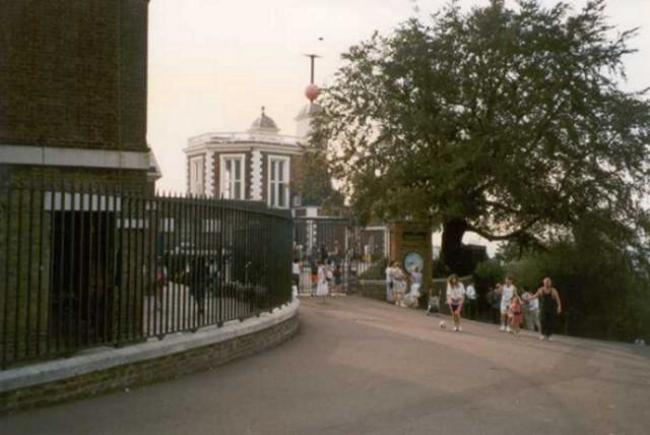
Named after John Flamsteed, the first Astronomer Royal who King Charles II set up in his new
observatory at Greenwich...
"To apply himself with the most exact care and diligence to
the rectifying of the tables of the motions of the heavens, and the places of the fixed stars, so as to
find out the so much desired longitude of places for the perfecting of the art of navigation."
The Octagon Room can be seen in the photo. The tall windows allowed for observations to be made with the long focus refractors and quadrants that were fashionable in the 17th century.
The Time Ball on the east turret was erected by John Pond, the 6th Astronomer Royal in 1833. The ball still rises and drops daily at 13:00 GMT precisely.
The famous 24 hour Greenwich clock can be seen to the right of the entrance. From what I can remember, below the clock is a bronze plaque with the standard units of British imperial measurement (yard, foot, inch, etc).
PHYSICAL OBSERVATORY

This magnificent piece of late Victorian architecture (now called the SOUTH BUILDING) is located at the southern end of the Royal Observatory enclosure. It was added by the 8th Astronomer Royal, Sir William H. M. Christie. Worked started in 1891 and was completed in 1899.
An interesting feature not seen in the photo is that above many of the windows is a stone plaque engraved with the names of the previous Astronomers Royal and instrument makers (like Graham, Bird, Troughton and Simms) that once supplied the observatory with equipment.
It was built at the time when astronomy was just starting to move on from purely determining the positions of the stars as aids to navigation at sea to the physical study of stars and nebulae; the birth of astrophysics. This was primarily due to the invention of the spectroscope in the 19th century.
At that time, the so called spiral nebulae were thought to be objects lying within our own Milky Way galaxy. Several decades were to pass before it was discovered that objects such as the Andromeda 'Nebula' were galaxies in their own right and located far beyond our own.
The dome once contained the Thompson 26" photographic refractor (1897) and 30" reflector fitted on the same mounting. Both these telescopes are now housed in separate domes at Herstmonceux.
The dome up until October 2004 housed a small planetarium.
THE GREENWICH MERIDIAN... LONGITUDE 00.00.00
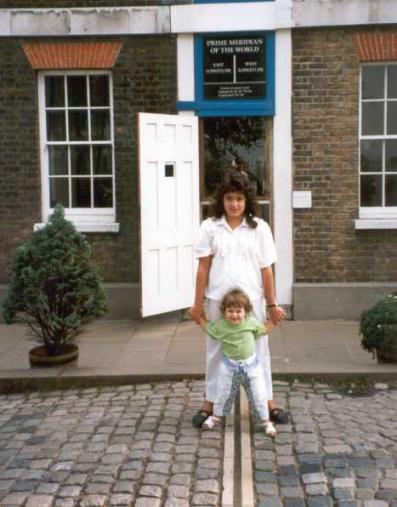
The brass strip (since replaced by an illuminated one) runs through the meridian courtyard and is a popular attraction with tourists where one can stand (like my daughter when young and her cousin) with one foot in the Earth's eastern hemisphere and the other in the western hemisphere!
The strip marks the north/south axis of the Airy Transit Circle which is housed in the building behind. This instrument designed by the 7th Astronomer Royal, Sir George Biddell Airy was used from 1851 up until the 1930's to determine Greenwich Mean Time (GMT). The last observation with the ATC was made in 1954. In 1884 by international agreement, the Greenwich meridian was adopted as the world's Prime Meridian. The Time Zone system uses this as a reference point where a position in longitude of 15 degrees east or west of Greenwich equates to a change in time of plus or minus one hour respectively.
WHATEVER HAPPENED TO GMT
The term GMT has since been replaced by UTC (Universal Coordinated Time) which is based on measurements from atomic clocks around the world and corrected for variations in the rate of the Earth's rotation.
As International Atomic Time (TAI) runs at a constant rate and does not know about changes in the rate of the Earth's rotation, corrections known as Leap Seconds are occasionally introduced into UTC. These keep atomic time and civil time (formerly GMT) to within one second. Since 1972 when UTC was adopted as the world's time keeping system, 26 leap seconds (June 2015) have been added which shows that the rate of the Earth's rotation is gradually slowing down. The IERS in Paris decide when a leap second needs to be introduced.
THE ROYAL OBSERVATORY MOVES TO HERSTMONCEUX IN SUSSEX
By the mid 1930's, observing conditions at Greenwich due the expansion of London had deteriorated so badly that the 10th Astronomer Royal, Sir Harold Spencer Jones recommended that the observatory should be moved to a better location. Preliminary investigations of suitable sites were carried out in 1939, but the outbreak of WWII brought this work to a halt. Although some observations were still carried out at Greenwich during the war (e.g. photographic plates taken of daily of sunspot activity) much of the valuable equipment was dismantled and moved out of Greenwich for safe keeping.
In 1946, the Admiralty purchased Herstmonceux Castle and its grounds (370 acres of land) and in 1948, Spencer Jones moved into his new residence in the castle. The library, Nautical Almanac Office (NAO) and Chronometer Department soon followed, but it would take 10 more years before the move was completed and all the telescopes in operation. Major building work started in 1953, the final phase was the completion of the West Building which housed the Time Department, the NAO, staff offices and workshops, etc. This was handed over in 1958.
Due to the long association with the old Royal Observatory at Greenwich, the new establishment was renamed the Royal Greenwich Observatory, Herstmonceux (RGO) and prospered for the next 25 years or so under the directorship of Sir Richard Van Der Riet Woolley (the 11th Astronomer Royal and the last to have taken up residence at the observatory) and the RGO directors who followed him after he retired in 1971. However, by the 1980's things were not looking good for the future of the RGO. The once clearer skies over Sussex had deteriorated also and by this time, virtually all the observing activities had moved over to the RGO's overseas station on the island of La Palma in the Canaries.
HERSTMONCEUX CASTLE

A magnificent building and the first castle in England to be build in brick in 1440 by Sir Roger de Fiennes. Over the years it fell into ruin, but was restored by later owners during the early part of the 20th century. Check out the Herstmonceux Parish pages for a detailed description of its history.
The castle housed the library, living quarters for the director, rooms for night duty astronomers and the staff refectory.
Just strolling over to the castle from the West Building for lunch was an enjoyable experience! The dining hall from what I remember with its high vaulted roof and tall narrow stained glass windows added to the ambience of the place and made lunch times even more memorable.
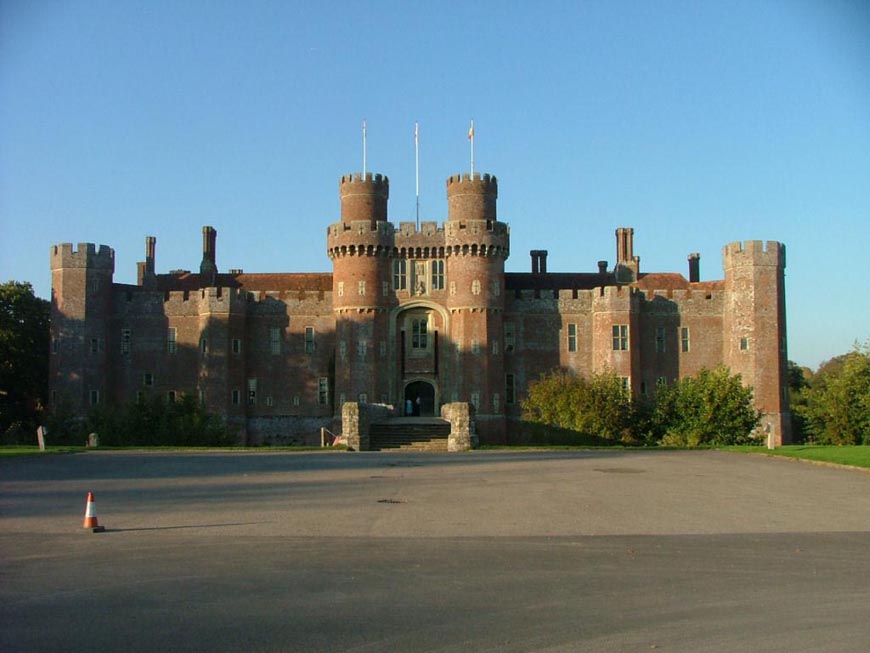
Facade looking north
This photo was taken on my last visit in October 2011 to attend an RGO staff reunion held in the castle.
TERCENTENARY SUNDIAL
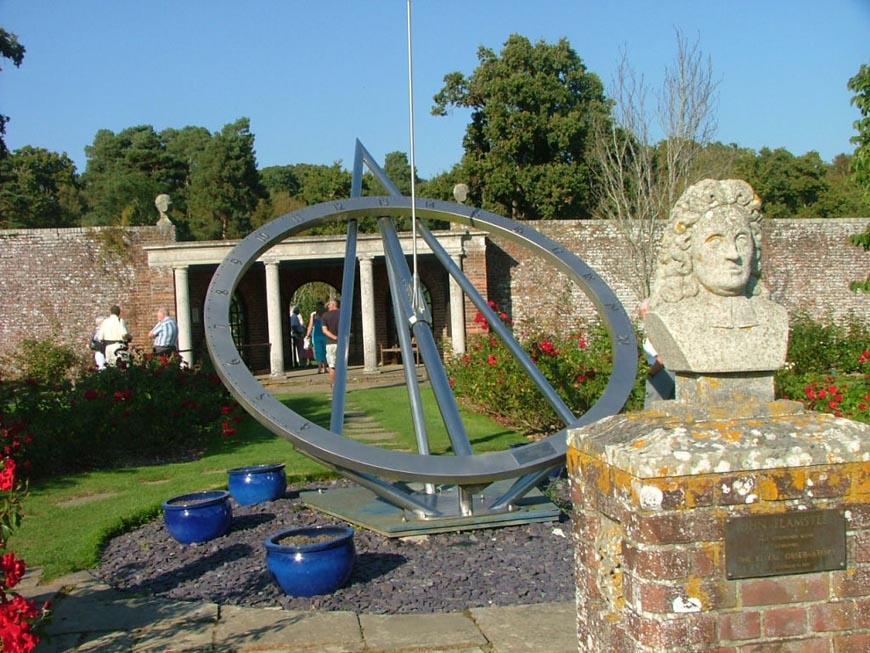
Now returned back from Cambridge to its rightful place in the ornamental gardens at Herstmonceux castle
The sundial chosen to commemorate the Tercentenary of the founding of the Observatory at Greenwich (in 1675) is called a reclining equiangular sundial. The angle of reclination was deliberately chosen so that the gnomon would be vertical. In selecting a dial for this historic occasion it was decided that the dial should be capable of giving the time in GMT correct to a minute that it should be easy to read by members of the public. As seen by the shadow cast by the gnomon, I took this photo at 15:00 (3pm)
A RAINY DAY AT THE ROYAL GREENWICH OBSERVATORY, HERSTMONCEUX, SUSSEX
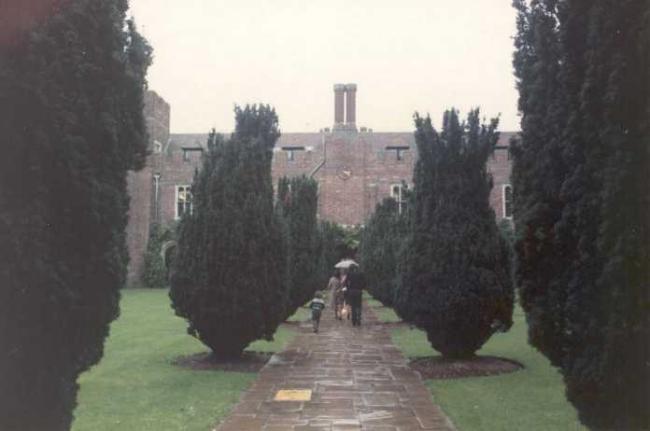
Federation of Astronomical Societies annual convention in 1982
I remember the day well. The weather was appalling, but most enjoyable all the same. Many of the photos that follow were taken during this visit.
Passing through the south entrance as shown in the photo brings you into the castle courtyard. Beyond this are the magnificent ornamental gardens. A large sundial of a unique design was erected there in 1975 to commemorate the 300th anniversary of the founding of the Greenwich Observatory.
THE EQUATORIAL GROUP OF TELESCOPES
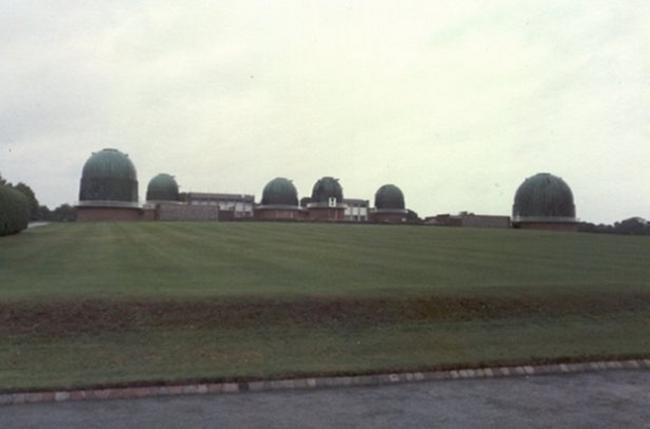
This photo shows the six domes of the Equatorial Group of Telescopes located on the higher ground to the east of the castle.
The domes from left to right housed the following telescopes when I worked there in 1986 and are the same today :
Dome E
Thompson 26" refractor
Dome A
Thompson 30" reflector
Dome B
Yapp 36" reflector
Dome D
Astrographic 13" refractor
Dome C
Hewitt satellite camera
Dome F
The 'Congo Schmidt'
A CLOSER VIEW OF THE EQ GROUP
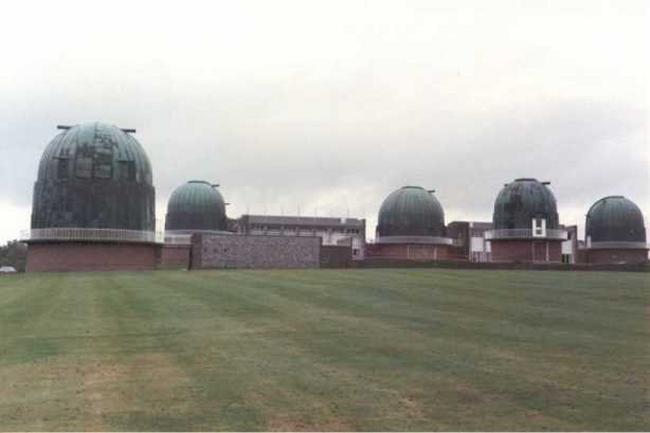
This was constructed in the 1950's when the Admiralty still ran the observatory and no expense was spared. The finest materials were used throughout even including flint knapped walls.
To preserve the view to the south, a haha was constructed to give the effect that the lawns extended down to the coast.
As a requirement that the domes blended in with the surrounding countryside, they were clad with copper sheets that would soon weather in time and produce the green patina which can be seen today.
I would loved to have seen them when new with the copper domes gleaming in the sunlight.
A, B AND C DOMES OF THE EQ GROUP
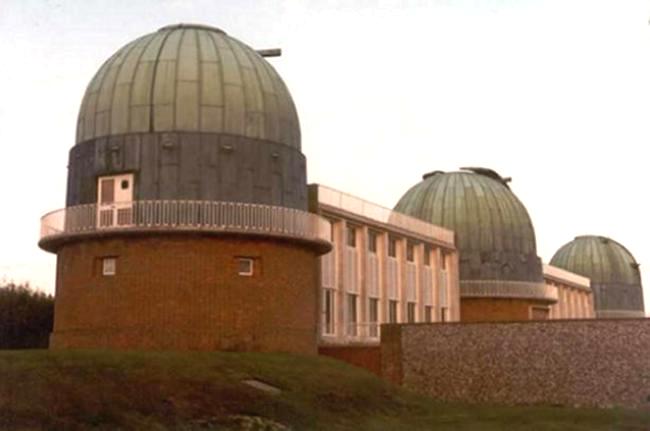
The original intention and layout being that these three domes housed the REFLECTOR telescopes and domes D, E and F, the REFRACTOR telescopes. The buildings in between once contained optics labs, darkrooms and an aluminising plant for re-coating the mirrors.
The bad news... By the time RGO moved from Herstmonceux to Cambridge in 1990, some of the telescopes and domes were unusable due to lack of maintenance. The telescopes were eventually stripped down to the bare essentials and mothballed.
The good news... The EQ Group was taken over by a charitable company called Science Projects. In 1995, the EQ Group became the Observatory Science Centre with a science exhibition and the telescopes are gradually being restored to their former glory.
Click here to see what EXCELLENT WORK has been done by the Observatory Science Centre over the last 10 years.
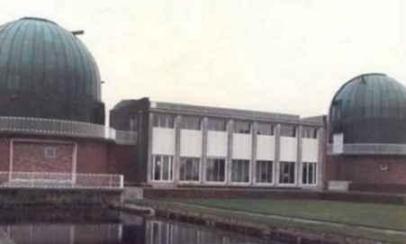
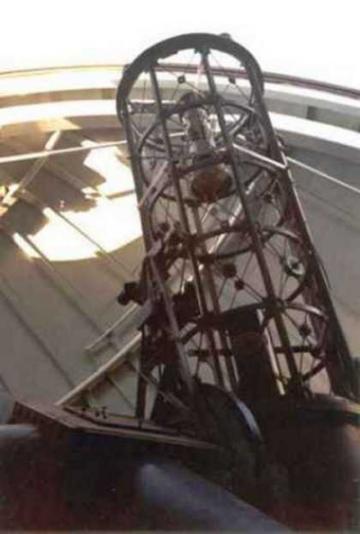
ORNAMENTAL POND IN FRONT OF DOME B
Whoever designed this obviously had no idea of the requirement to preserve astronomical seeing quality! The mists rising off it during warm summer nights must have been detrimental to the quality of the images. Not forgetting to mention the story that I heard of an astronomer falling into it tired after a nights observing!
YAPP 36" REFLECTOR IN DOME B
This telescope made by Grubb Parsons was a gift in recognition of the service of Sir Frank Dyson, the 9th Astronomer Royal from an admirer, W. J. Yapp (a businessman) in 1931 who Dyson had never previously met. The telescope was in use at Greenwich by 1934.
DOME D AND THE ORNAMENTAL POND
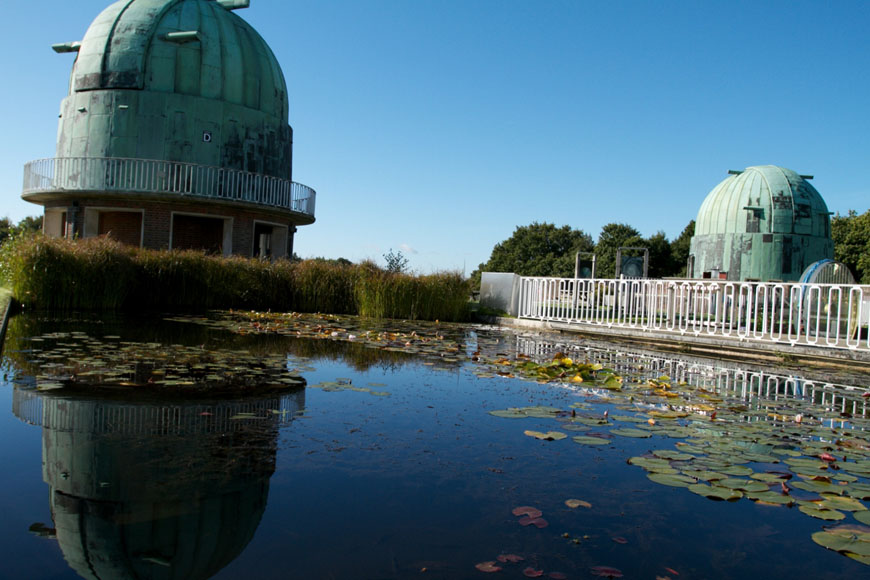
This is the smallest dome in the EQ Group and houses the 13" Astrographic refractor. Some 20 telescopes of similar specifications were made in the late 19th century and installed at observatories around the world to produce the 'Carte du Ciel' (Map of the Sky) with each 16x16cm blue sensitive photographic glass plate covering a 2 square degree field. The project went on for decades and was never fully completed.
In later years at Greenwich and then at Herstmonceux, the 13" telescope (as was the 26" refractor) used to measure stellar parallax and proper motions. It was also used to monitor Quasars and Seyfert galaxies.
Image courtesy of the Observatory Science Centre
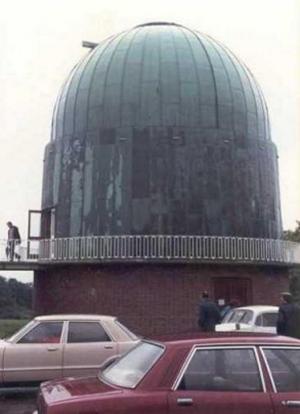
DOME E
This houses the Thompson 26" refractor. An interesting feature of this dome is that it has a rising floor so enabling easy access to the eyepiece/plate holder no matter in what position the telescope is observing at.
I knew some of the astronomers who were the last to have used this telescope and they told me the rising floor was not that reliable and would occasionally jam. Not good news for the duty astronomer! The floor of course must be lowered to gain access through the door to the left of the photo.
This telescope was primarily used to photographically record stellar parallaxes and proper motions. The RGO had a large plate library going back many years. Accurately measuring the positions of stars in the same area of the sky recorded on photographic plates taken many years apart will detect these very small movements. From this data, it is possible to calculate the distance of some of the closer stars relative to the Earth.
THOMPSON 26" PHOTOGRAPHIC REFRACTOR
This telescope made by Grubb Parsons was presented as a gift to the Royal Observatory in 1894 by the London surgeon Sir Henry Thompson (1820-1904). Thompson also gave funds for a 30" reflector which is in Dome A. Both these telescopes were fitted together on the same equatorial mounting in the dome of the Physical Observatory at Greenwich.
The 26" was designed specifically for taking images on photographic plates to complement the Grubb 28" visual refractor. This telescope was also moved to Herstmonceux in the 1950's, but later returned to Greenwich once the Onion Dome was restored.
A notable feature is that the 13" guiding telescope which can be seen mounted above the 26" in the photo was once the biggest in use at Greenwich, the Merz Refractor (The Great Equatorial) obtained by Airy in 1860.

THE EMPTY INT DOME
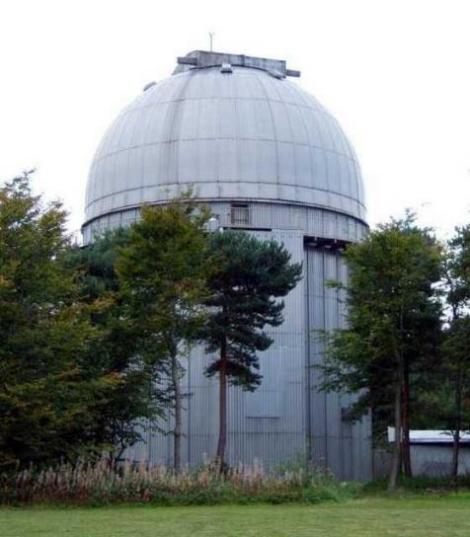
The building and installation of the 98" Isaac Newton Telescope (INT) was the greatest achievement of Sir Richard Woolley during his tenure at the RGO. It was inaugurated in 1967 by H.M. The Queen. As this telescope was paid for by the tax payer (it cost about £600K) it was stipulated that it should be made available for public viewing free of charge.
I saw it twice in the UK, once through the glass window of the visitors gallery and the second time from the observing floor during the open days of the Tercentenary of the RGO in 1975. However, due to the bad observing conditions in the UK, it seldom performed to its full ability and in 1979, it was dismantled and shipped to La Palma. It came into operation there in 1984.
I believe in some quarters questions were raised whether it should have been moved at all. A new 2.5 metre class telescope may have been more cost effective. The cost of re-siting the INT was huge due to the re-engineering work required for the telescope to observe at latitude 28o north, to supply a new Zerodur mirror (a full 100") and to provide a temperature controlled building and laboratories suitable for the F50 Coudé focus. This was never commissioned.
The empty dome now serves as a landmark for shipping in the English Channel. There was a plan to turn it into an Arts Centre, but that never happened.
Photo by Ian King (Sept 2005)
SATELLITE LASER RANGER (SLR)
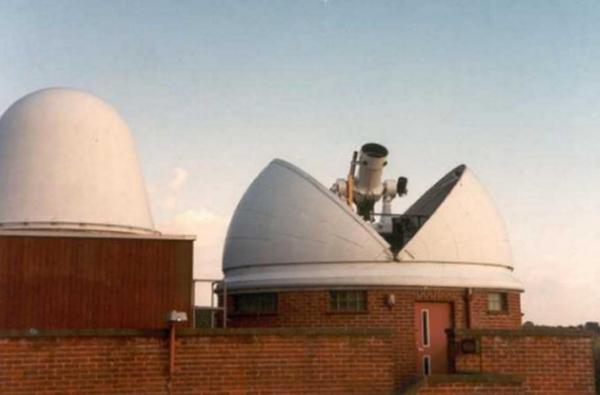
Now called the NERC Space Geodesy Facility. It is sadly ironic that the building and dome containing the SLR was the first piece of construction at Herstmonceux in 1949, but is now the last vestige of what was the RGO at that site. It is still in use today and has been in operation since October 1983.
The dome once housed the 6.25" Newbegin refractor which was used with a Photoheliograph for taking daily photos of sunspot activity. I remember seeing a projection of the sun with this in 1975 during the Tercentenary open days.
Shortly after the RGO moved to Cambridge in 1990, the running of the SLR was taken over by the National Environmental Research Council (NERC). Using this equipment and others like it around the world, it is possible to measure small effects such as continental plate drift.
The laser launcher is the tube to the left of the main telescope which detects the returned beam. The small dome to the left contains a radar which can turn off the laser if an aircraft passes over.
THE WEST BUILDING
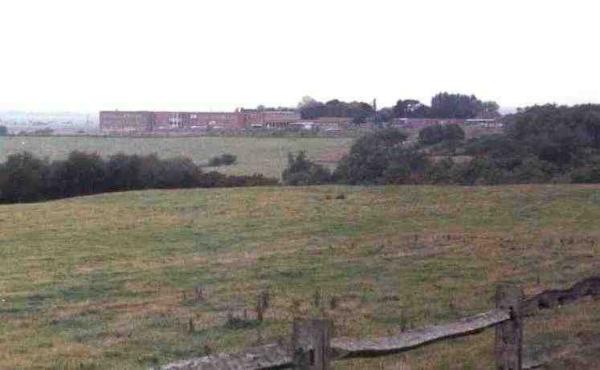
This was the last piece of construction at Herstmonceux and finished in 1958. A new wing was later added in 1969. All of the daily activities were based here and included the directorate, general office, the Nautical Almanac Office, various laboratories, the electronics and mechanical workshops, stores, etc. as well as many offices for personnel. The chronometer department had gone by the time I started. I presume not required due to advancements in electronic navigation. On the ground floor was the computer department, the main data processors being a Vax 11/780 and 11/750 at the time.
In an out building close to the mechanical workshop was the Telescope Simulator. It consisted of a movable frame with a turntable on which instruments could be mounted and tested for flexure. I spent quite a lot of time on this checking out the JAG (JKT CCD and TV Acquisition and Guider box) destined for the 1 metre Jacobus Kapteyn Telescope on La Palma. For the next 16 years, I looked after this instrument as if it were my own.
The Time service was housed the basement. In 1986, it still provided the famous 6 pips which were sent to the BBC for transmission via their TV and radio networks. By this time, the atomic clocks were failing and the funding to maintain or replace them was not forthcoming. The Bureau International de L'Heure (BIH) in Paris was now disseminating universal time (UTC) and the need for the RGO to provide time into the world network of atomic clocks was deemed un-necessary. When the RGO moved to Cambridge, the Time Service was shut down. During my time working for the RGO/ING on La Palma, I maintained and calibrated the time services for the telescopes. One of the most reliable pieces of equipment to have been designed and built in the RGO labs in the early 1980's. My tribute goes out to the engineers who designed it.
THE BEGINNING OF THE END
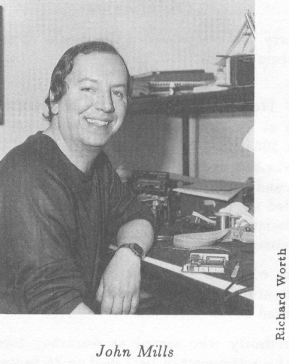
When I joined the RGO in January 1986 (photo taken in the electronics lab during my first week), the morale of the staff had reached rock bottom! The Science and Engineering Research Council (SERC) who then ran the observatory had decided to move the RGO. The feeble excuse given was that it was too remote and lacked interaction with the universities. Petitions were raised, 'Save the RGO' T-shirts were printed, Patrick Moore supported us, but all to no avail. The SERC had decided it must move and that was final.
I remember well sitting in at the staff meetings in the castle ballroom listening to representatives of various universities and other scientific establishments putting forward their cases to why the RGO should be moved to their establishment. Some of these meetings got quite heated during question and answer time. I recall a questionnaire was sent to all members of staff asking them to tick their preference in order of choice as to where the RGO should be re-sited. Along with Manchester, Edinburgh and Cambridge (the site eventually chosen) was the option to stay at Herstmonceux. Probably just a ploy by the SERC to appease the staff that such an option was still open. However, that certainly wasn't the case.
The general feedback I got was that the majority of the staff had ticked the box to stay at Herstmonceux. Hardly surprising as many had lived in the area for years and didn't want to move. Not forgetting to mention that as a working environment, it was probably one of the best in the UK; such a beautiful place. Although I was going to La Palma for a three year tour, I had just moved down from London to Hailsham and was looking forward to returning there after my tour and continuing to work at the RGO, but that was never to be.
The move of the RGO from Herstmonceux to Cambridge in 1990 was supposed to be self financing in that the sale of the castle and grounds would cover the costs. I very much doubt if that was the case as the Herstmonceux estate was sold for a ridiculously low price to a property developer who wanted to turn the site into a golf course, convert the castle into an hotel and build executive houses on the grounds. That soon turned sour (fortunately) when Wealden District Council refused him planning permission which in retrospect was hardly surprising. There then followed a period of uncertainty with some prospective overseas buyers backing out at the 11th hour. Eventually the estate was purchased by Dr. Alfred Bader in 1994 as a gift for Queens University, Kingston, Ontario, Canada to set up an International Study Centre for their students. The castle is now the teaching facility and the West Building (now called Bader Hall) has been converted into the hall of residence. The EQ group of telescopes became the Observatory Science Centre in 1995.
THE FINAL CHAPTER
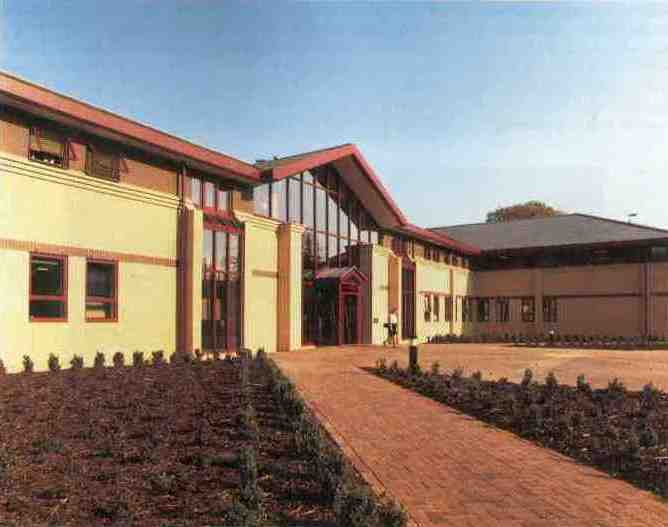
The new RGO building at Cambridge (photo by David Calvert)
To this day, I have no idea why this went ahead as in 1998 THE RGO WAS CLOSED FOR GOOD! One of the first actions of the then new labour government. Although in my opinion no where near as idyllic as the Herstmonceux site, the RGO building at Cambridge was very pleasant. I spent a week or so there in 1993 working on a project destined for La Palma that I would eventually be responsible for. Many of the staff that had moved up from Sussex hoped at last things would be stable, but soon after the move, the very existence of the RGO came into question. In the meantime, the SERC due to its unwieldy size had been broken up by the government into smaller research councils. The royal observatories now came under the control of the Particle Physics and Astronomy Research Council (PPARC).
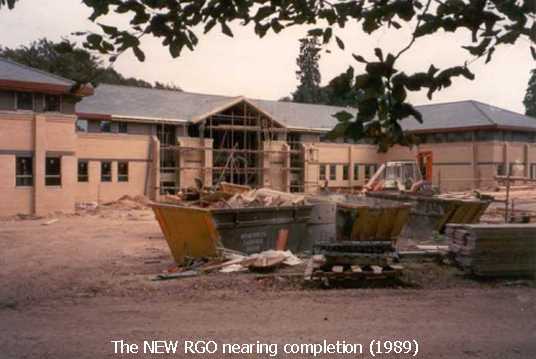
In 1991, a management review panel recommended that both the RGO and the Royal Observatory Edinburgh (ROE) and their respective overseas observing sites; the Isaac Newton Group of Telescopes (ING) on La Palma and the Joint Astronomy Centre (JAC) on Hawaii come under the control of a single director. It must have been about that time when the name, ISAAC NEWTON GROUP OF TELESCOPES was officially adopted as when I started working on the island in 1986, it was simply known as LPO, the La Palma Operations division of the RGO. The post of Super Director for all four establishments was taken by Prof. Alec Boksenberg in 1992 who was head of the RGO at the time.
However, this state of affairs didn't last for long. In 1995, ANOTHER review panel decided that the island observatories should have more autonomy and that a UK Astronomy Technology Centre (ATC) should be set up. The ATC would carry out instrument development work being done at that time at the RGO and ROE for their respective island observing sites and would certainly bring about the closure of one (or both) of those establishments. Although one could see the rationale in the case for setting up a centralised technology establishment, in my opinion (and I'm sure many others who worked at RGO) what followed next can only politely be called a disaster.
Once again each establishment had its own director (Alec Boksenberg retired in March 1996). The position of director at RGO being taken by Dr. Jasper Wall in November 1995. I knew Jasper well as he was the Officer in Charge at the ING towards the end of the 1980's. In 1995 during deliberations as to where the ATC should be set up, the infamous Prior Options process was started. For reasons that only the bureaucratic mind can comprehend, a decision was made at government level that the privatisation of the royal observatories should go ahead and this was welcomed by PPARC. In that PPARC would still own the telescopes and installations, but the management of the island observatories and their UK bases would be tendered out. We all thought how can an observatory be privatised as its hardly a money making organisation, but the laborious exercise of preparing tender packages to put out to prospective management organisations went ahead. The bottom line being that in November 1996 the exercise was suspended due to, "Unforeseen legal and financial problems". Incredible... A total waste of time and money!
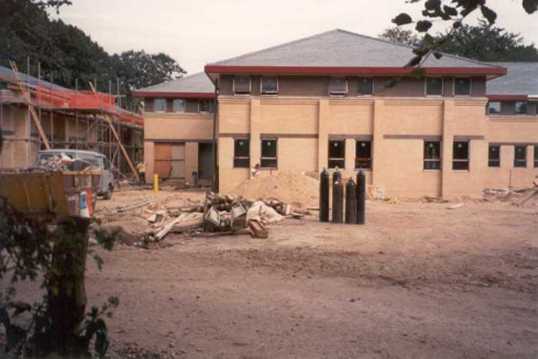
However, this didn't stop the wheels of bureaucracy turning. A decision still needed to be made of where the ATC would be located and ultimately the fate of the royal observatories. PPARC didn't waste anytime coming to this decision. In the Spring of 1997 we finally all knew the outcome. PPARC announced that the RGO would be closed and the ATC to be set up at the ROE site in Edinburgh. The Daily Telegraph broke the news on the 24th May 1997 with the official announcement to staff made on the 4th July.
In an attempt to save the RGO, a business plan was proposed by management that would keep the establishment running, but as an independent academic institute with income arising from outstanding contracts with PPARC and from other companies. However, PPARC would have none of this and after 323 years of continuous operation, the doors finally closed at the RGO on the 31st October 1998... The oldest scientific establishment in the UK.
AFTERMATH
Although the RGO is now relegated to the pages of history, one can't but think if there was a hidden agenda as to why this should have happened? What really was the motive behind moving the RGO from Herstmonceux to Cambridge in the first place? A move which cost millions of pounds and a total waste of money considering that 8 years later, the RGO was closed for good. Was this just the first part of a grand plan to bring about the demise of the RGO?
By the mid 1980's, observing was now being exclusively carried out on La Palma and the question was raised of why an observatory in the UK was needed at all. The EQ group of telescopes at Herstmonceux could still have done useful work as the science of astronomy covers many branches. Although big telescopes on mountain top locations are primarily there to probe into the furthest depths of the universe, smaller telescopes are better suited to astrographic work where only after many years of observations can data be reduced regarding the proper motions of stars. The RGO was well advanced in this study due to its longevity. This work could have continued, but as galactic astronomy was no longer 'Big Science', the EQ telescopes were abandoned and not maintained.
Regarding the move to Cambridge, I believe Sir Patrick Moore was heard to have said that this was, 'The Beginning of the End' for the RGO. How right he was! Another question is why wasn't the ATC located at Cambridge, in a NEW BUILDING and located in one (if not the best) technological centres in the UK? The building would have been more than adequate for the technology centre. The were plenty of rumours going around at the time as one can well imagine. Did someone in a high position have a personal grudge against the RGO and was determined to bring about its demise? I don't know, but if so they certainly succeeded... The rest is history.
Some readers may think that I just simply enjoy living in nostalgia. I probably do, but the closure of the Royal Greenwich Observatory is another example whereby the nation has lost part of its heritage due to bureaucracy and where the need to save a few quid is valued higher than the survival of a world renowned institution.
I dedicate this article to Jasper Wall and to those who worked at the RGO in the final years who tried to save it from closure. I'd be only too pleased to hear from anyone regarding my article and especially from any former RGO employees who would like to put in their 'pennies worth'... !
Email to: ejmills [at] telefonica [dot] net
REFERENCES AND LINKS
- The Royal Greenwich Observatory W. H. McCrea FRS (HMSO 1975)
- The History of the Telescope Henry C King (Charles Griffin & Co Ltd 1955. Reprinted by Dover Publications NYC 1979)
- The RGO newsletters GEMINI (later renamed SPECTRUM ) for information to refresh my memory regarding later events which lead to the closure of the RGO in 1998.
Since writing my article, I've found these web pages:
- In Memoriam: The Royal Greenwich Observatory, 1675-1998 by David Harper... Another ex-RGO employee whose comments I agree with.
- CASTLE IN THE SKY – The story of the Royal Greenwich Observatory at Herstmonceux by Chas Parker... An excellent article going into much greater depth than I could have ever written on the subject.
- A PERSONAL HISTORY OF THE ROYAL GREENWICH OBSERVATORY AT HERSTMONCEUX CASTLE, 1948-1990 – By George A. Wilkins (2009) A very well written and in-depth article from someone who worked there from the beginning. Covering every aspect of the RGO during the Herstmonceux years.
- Royal Greenwich Observatory Society (RGOS) Roger Wood's website for ex-RGO staff. A place where fond memories can be shared.

